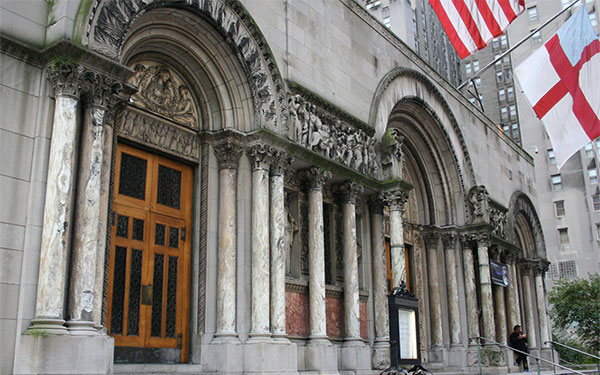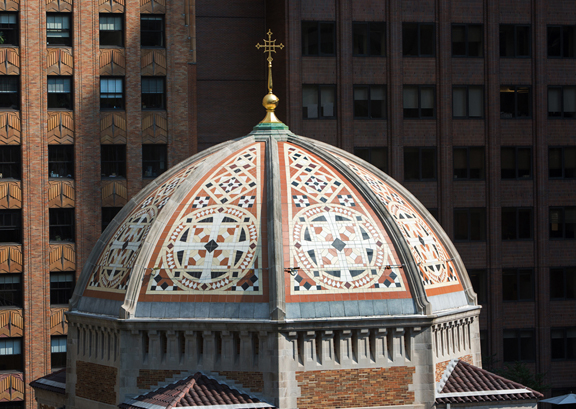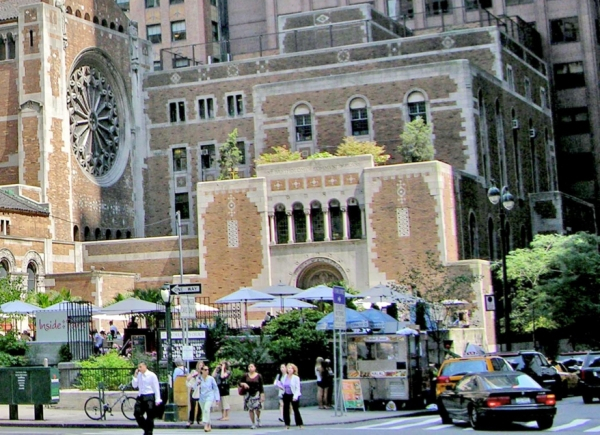St. Bartholomew's on Park Avenue 1931 2014
Description of the Site
Constructed between 1916 and1918 and completed in 1930, the St. Bartholomew’s site, Romanesque in inspiration but with rich Byzantine decoration, is an outstanding example of the work of Bertram G. Goodhue, one of the nation’s foremost ecclesiastical architects. St. Bartholomew’s Church, the larger of the site’s two buildings, is entered through its remarkable Triple Portal, designed in 1903 by Stanford White of McKim, Mead & White for the church congregation’s previous location on Madison Avenue at 44th Street. The Triple Portal is modeled after the porch of the Abbey Church of St. Gilles-du-Gard in southern France. Its bronze doors and friezes are the work of distinguished American sculptors Daniel Chester French, Andrew O’Connor, Philip Martiny, and Herbert Adams. Inside the Church one also finds exceptional works by architectural sculptor Lee Lawrie and mosaicist and muralist Hildreth Meiere.
SIte and Setting
St. Bartholomew’s Church and Community House occupy a block-long site on Park Avenue between 50th and 51st Streets in midtown Manhattan. The majority of buildings along Park Avenue are multi-story office towers constructed in the mid-to-late twentieth century. The street is a wide boulevard divided by a narrow median of trees, grass and seasonal plantings. Park Avenue’s unusual (140-foot) width, and the fact that the north-south axis of the site occupies an entire city block, enhances its architectural impact. To the south and east are two other New York City landmark buildings: The 1929 Waldorf-Astoria Hotel, and the 1931 General Electric (originally RCA Victor) Building. The latter, which stands behind the Church on its eastern flank, was designed by Cross & Cross to harmonize with St. Bartholomew’s salmon-colored brick and limestone ornamentation. The Bartholomew Building Corporation, established by RCA in 1929 to realize the Cross & Cross design for its new headquarters, was so named in deference to the company’s already much admired neighbor.
St. Bartholomew's Church
The Church building, designed in the form of a Latin cross and constructed of reinforced concrete, has a decorative brick and Indiana limestone exterior. The bricks vary in size and color, but the overall effect is one of subtly shaded earth tones reminiscent of many large building facades in Italy. Brick is also employed as ornament in geometric and foliated patterns, along with marble tessera and carved stone figures set into the walls. This repousse-like treatment harmonizes with the building’s more prominent limestone trim and architectural sculpture to create the intricate human-scaled exterior for which it is so admired. Entrance is gained by climbing a short flight of limestone steps leading to a one-story limestone narthex (or vestibule) extending across the west facade. A one-story chapel fills the southwest intersection of the nave and the transept with its own exterior entrance on Park Avenue a adjacent to the narthex. Joined to the south side of the church, set well back from Park Avenue, is the six-story Community House, constructed of steel and concrete with a brick and limestone exterior. Not only is the Community House set back from Park Avenue; its west-facing façade is stepped back in three segments, creating roof terraces. This design helps minimize the architectural presence of the Community House in relation to the Church.
The Triple Portal

The main Park Avenue entrance to St. Bartholomew’s Church is through a limestone structure, known as the “Triple Portal.” It was designed by Stanford White in 1903 and moved from the congregation’s previous location on Madison Avenue at 44th Street in 1918. Made of white limestone and subtly-hued Cippolino marble, the Triple Portal forms the facade of a seventy-five foot long narthex, providing a monumental base for the tall pierced screen of the Church’s west window rising above it. The iconography of the portal’s sculptural program centers on the life, passion and resurrection of Jesus Christ, juxtaposed against a series of Old Testament pre-figurations and prophecies. Each individual portal also frames a tall bronze door depicting in bas relief episodes from the Old and New Testaments. This sculptural work was divided among four prominent artists: The large central doors, the central tympanum and lintel, and the two large flanking friezes are by Andrew O’Connor with oversight from Daniel Chester French. On the right, the doors, tympanum and lintel are by Philip Martiny, while those on the left are by Herbert Adams. As Goodhue himself wrote, White’s Triple Portal “is universally regarded, by architects and public alike, as one of the most beautiful things, perhaps the most beautiful thing of its kind in America.” (Goodhue, “The Proposed New St. Bartholomew’s Church,” January 16, 1915, St. Bartholomew’s Archives, 1915.)
Indeed, it seems not too much to say that Stanford White’s Triple Portal gave Goodhue the freedom to engage in stylistic experimentation. Like White, who introduced an Italian aesthetic into his reinterpretation of the porch of the French Abbey Church of Saint-Gilles-du-Gard, it seems that for Goodhue also, eclecticism was often the handmaiden of truly creative design. One sees this clearly in the iconographic program for St. Bartholomew’s exterior sculptural ornamentation, which dramatically illustrates Goodhue’s willingness to draw on a variety of historical sources, ranging from Venetian Romanesque to English Gothic, all the while incorporating rearranged decorative elements from St. Bartholomew’s previous Madison Avenue location. In the iconographic program, there is great variety as well in the materials used and in the alternation between freestanding sculptures and bas reliefs, but all occurring within the unifying context of a liturgically coherent program.
The Portal of St. Bartholomew's Church in New York City by Percy Preston Jr.
Building Diagnostics and Conditions Survey: Columbia University Graduate School of Architecture, Planning and Preservation, Historic Preservation Program
The Great Dome

Initially, Goodhue envisaged a tall tower enclosing a dome (a combination he referred to as a “Ciborium”) rising above the Church’s interior crossing. Early on, however, the Vestry rejected that idea because of its projected cost. In fact, a shortage of funds delayed completing the Church until 1929-1930. With Goodhue's sudden death in 1924, the definitive design for St. Bartholomew’s "Great Dome" (replacing Goodhue’s drawn but still considered too expensive Ciborium) was furnished by Goodhue Associates, his successors. Based on Goodhue’s design for the dome of the California State Building, Panama-California Exposition, San Diego, 1911-1915, it is placed atop a square base built with the body of the church and is actually two domes, one inside the other, the inner structure being made of relatively lightweight tile. Its eight exterior planes were originally decorated with colored marble, granite and terra cotta tile and crowned with a gilded cross. In 2017 the dome was re-clad with 6,640 terra cotta tiles.
The Community House

A positive outcome of the closing of the Church's Parish House on Forty-Second Street was the construction of the Community House with proceeds from the sale. Set back from Park Avenue along 50th Street the six-story Community House is joined to the Church's south side by a cloister-like loggia and garth, or small enclosed garden. With architect Bertram Goodhue’s death in 1924, it fell to his associates in partnership as Mayers, Murray and Phillip to design and oversee the Community House’s construction, which was completed in 1928. Art Deco in style and also faced with variegated salmon and cream-colored bricks interspersed with Indiana limestone, the Community House is essentially a cluster of stepped cubes with flat roofs that function as outdoor terraces.



